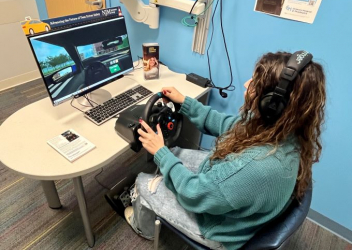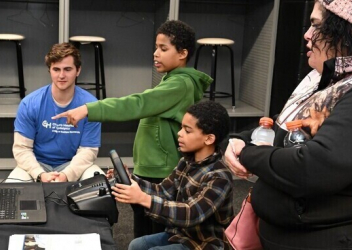Research In Action
Research In Action
Breadcrumb

As a pre-med student at the University of Pennsylvania studying Health Policy and Law, I have greatly enjoyed my time this summer as a Clinical Research Assistant for the Neuroscience of Driving team at the Children’s Hospital of Philadelphia’s (CHOP) Center for Injury Research and Prevention (CIRP). I am passionate about the incredible work taking place at CIRP studying driver assessment and training as it uniquely reflects my academic focus on clinical and policy-driven healthcare in diverse populations with consideration of racial and socioeconomic determinants of health.
In Pennsylvania, driver education is not mandatory for gaining a license, meaning that many young drivers have no formal training in road safety before they are licensed. Without this requirement, many do not have access to this resource as it is not only expensive, but teens may live in what is known as a Driver Training Desert, a geographic area that lacks access to driver training. Therefore, the work being done at CIRP is especially important to ensure our Philadelphia/Pennsylvania adolescents stay safe on the roads.
My work this summer focused specifically on a niche in driver education, learning about and helping with the implementation of the Virtual Driver Assessment (VDA), an assessment that can uniquely identify what skills a given driver may need to practice and then deliver customized feedback. The VDA utilizes the Ready-Assess™ platform developed by Diagnostic Driving, Inc., an AI-driven virtual driving assessment that provides the driver with the insights and tools to improve. The VDA was tested in Ohio licensing centers to assess skills in common crash scenarios immediately before the license exam. The results confirmed that the VDA is able to predict licensing and crash outcomes.
Too often, new interventions that prove effective can take too long to be implemented in the field, and sometimes are still inaccessible to communities that really need resources the most. Yet in my time at CIRP, I was most struck by the concerted effort to make the VDA accessible to diverse populations and to provide useful critical feedback to new drivers who may not otherwise have the opportunity to be given formal feedback on their driving skills.
In partnership with The Possibilities Project, the VDA is currently offered in 26 CHOP Primary Care Network offices throughout Pennsylvania and New Jersey. The offices serve patients in urban, suburban, and rural settings, and reflect diversity in race, ethnicity, and payer status. A little over half (53%) of our patients are White, 25% are Black, and more than 99% are covered by Medicaid.
Having the VDA implemented in communities with such varying demographics is an important opportunity because it allows the work being done at CIRP to reach many groups of adolescents. Not only is the VDA a great resource for young drivers to improve and prepare for their on-road driving exam, but it also can be a helpful resource for parents to determine if their child is able and ready to learn to drive.
We have ongoing research studies taking place to track how teens learn to drive and what interventions can improve driver safety. Interested families can email us to get involved at: DrivingSimulator@chop.edu.




